| |
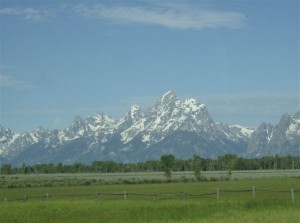 Thank y’all for comin’ on over to the campfire! You’ve probably been wonderin’ about Cookie and me…then again maybe not! We’ve been on a break, but don’t fret we’ll be back on the trail soon. I’ve been knee deep in writin’ and Cookie has been knee deep in…well y’all know! So please don’t give up on us and keep checkin’ back! In the meantime enjoy the Saturday story RACE TO MARRY! Thank y’all for comin’ on over to the campfire! You’ve probably been wonderin’ about Cookie and me…then again maybe not! We’ve been on a break, but don’t fret we’ll be back on the trail soon. I’ve been knee deep in writin’ and Cookie has been knee deep in…well y’all know! So please don’t give up on us and keep checkin’ back! In the meantime enjoy the Saturday story RACE TO MARRY!
We sure do appreciate y’all hangin’ in there with us!
–Kirsten Lynn
Howdy, Folks!! It’s a beautiful day on the trail! We’re movin’ out of the darker side of Wyomin’s past…well… ‘cause frankly Cookie and me were gettin’ a might depressed. Cookie’s stew has never been particularly savory, but we were gettin’ sour stomach!
So today we’re visitin’ with one of Wyomin’s more colorful characters, Caroline Lockhart! I have to tell ya outta all the people we’ve met on the trail Ms. Lockhart is a favorite for Cookie and me! Now we’re particularly fit to be tied ‘cause Ms. Lockhart is Wyomin’s first woman author and a founder of the Cody Stampede! A woman who writes AND is involved with rodeo…Can I be her when I grow up?!
“Wyoming Girl’s First Novel is Successful…Equals Owen Wister in Thrilling Western Story!” (And no this isn’t about yours truly…yet) Announced the Cheyenne State Leader on March 11, 1911. “Not since the publication of The Virginian has so powerful a cowboy story been told as Miss Caroline Lockhart’s novel Me—Smith.”
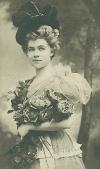 Lockhart, 1900
Photo courtesy American Heritage Center, #ah003129 Born in Illinois, Caroline Lockhart spent fifteen years as a newspaper reporter in the East. But in 1904, she turned her thoughts to writing a novel and her feet to the West she always admired. When she stepped off the train, the thirty-three year old cut a fine figure with gold-burnished hair that caught the sun and the eye of many a cowboy. What caught Caroline’s eye was the town of Cody, Wyoming and the diverse peoples of the West; sheepherders, cowboys, Indians and even dudes from the East. The town Caroline first laid eyes on had 210 inhabitants and 14 saloons, “none too many for such an arid landscape,” according to Caroline.
Though not well-known today, during the 1920s, Lockhart reached her goal of becoming “the best known woman west of the Mississippi.” Her novels The Fighting Shepherdess and The Man from the Bitter Roots had been made into major motion pictures, and she had recently finished a stint as a celebrity journalist at the Denver Post. The Park County Enterprise reported on her trip to Los Angeles. “Los Angeles, the mecca of artists and authors has a famous visitor this week in Caroline Lockhart who wrote The Fighting Shepherdess and other best sellers of the day. Miss Lockhart’s first visit upon her arrival was to the Louis B. Mayer studio.” There she met with Douglas Fairbanks regarding the adaptation of her nearly completed novel The Dude Wrangler.
Lockhart had a passion for the Old West; for the open-range cattle ranches before they were fenced and turned to dry-land farming, for the old characters who fought and scraped and survived the harsh land, and she loved, with a passion, horses. Her passions matched those of her contemporaries in Western novelists, such as Owen Wister and Zane Grey. But unlike other writers, Lockhart lived fulltime in the West. Therefore, her lifestyle brought authenticity to her work, not the depictions of what Easterners wanted the West to be. Also, Caroline set her stories during the 20th Century, unlike other authors who set their tales in the Old West. She wanted Wyoming to recognize its place in the present, and not fade into the past like the Midwestern frontier in the light and luxuries brought by the industrialization of the 20th Century. Wyoming’s heritage was dying on the altar of railroads, electricity, and automobiles. Who needed horses? Why would anyone care about the American Indians? Only a small tip of the hat should be given to men such as Buffalo Bill Cody, whose legendary status was diminished by divorce and financial ruin.
Lockhart’s novels breathed life back into Western culture. “Three cheers and a tiger for Caroline Lockhart. She is our only live, living author. What Caroline doesn’t know about Wyoming and Wyoming folks isn’t much. She can make a cavalier out of a sheepherder and a courtly gentleman from the crudest cowpuncher,” a Wyoming newspaper reported.
Almost 50 years old when her novels reached their peak, Lockhart appeared decades younger and “was one hell-of-a-good-lookin’ woman” according to one of her cowboy friends. And Caroline Lockhart had many cowboy friends. Although she never married, she juggled multiple boyfriends offending many of the more conservative citizens of Cody. Along with her long line of lovers, Codyites were fanning themselves over Lockhart’s penchant for drinking at a time three-quarters of the town voted for Prohibition. Lockhart, on the other hand, threw lavish parties in her Cody home where there was no lack of the demon liquor. In 1921, The State Tribune of Cheyenne published Lockhart’s letter to J.D. Woodruff in Shoshoni supporting his stand against Prohibition. “Mr. Woodruff: I have finished reading your letter to Governor Brooks printed in the Tribune, and I am impelled to write and congratulate you upon your common sense and courage. It sounds like Colonel Henry Watterson—a sane voice in the mob always. What you say finds an echo in the heart of every person who is not a hopeless bigot…”
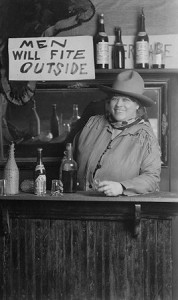 Lockhart
Photo courtesy American Heritage Center, #ah002656 Lockhart was, to say the least, a controversial figure, but she was a woman with “passion, gumption, and money to get things done.” One thing she wanted to see done was an event to honor the Old West. So, on April 20, 1920 the bestselling novelist with a flair for publicity, gathered with other leading citizens of Cody; Ernest J. Goppert, Sr., an ambitious young attorney; Irving H. Larom, a Princeton-education owner of a prominent dude ranch; Sid Eldred, editor of the Park County Enterprise, the newspaper founded by Buffalo Bill Cody; and Clarence Williams and William Loewar, both men helped run the town’s small Fourth of July celebration. All agreed they wanted more than just a Fourth of July party, more than a rodeo and street dance. They wanted an event to bring back the Old West; an event to entertain and bring in tourists driving through the newly opened road to Yellowstone National Park.
The citizens who met in Lockhart’s house, and enjoyed her liquor, decided they would call this event “The Cody Stampede.” Lockhart persuaded them not to include the word “rodeo” in the title as it “sounded like a dude word and besides we did not know how to pronounce it.” Lockhart was elected the organization’s president. They sought to attract the finest contestants, which included one of Lockhart’s cowboy friends, champion bulldogger Pinky Gist.
The week after the meeting, Lockhart purchased, with four partners, the Enterprise. She took control of the newspaper and used it to promote the Stampede. Her Enterprise advertised such exciting news as: Toggery Bill securing “the Red Lodge Finnish orchestra and the only Mary Quilico for the Cody Stampede.” And when Miles City, Montana chose the same dates for their rodeo, Lockhart and company stood firm believing “if necessary, there are enough riders and horses in the surrounding country to furnish a good program without outside help. Bronco riders and Grand Opera stars, we have learned from experience, have similar temperments [sic], and while some of the outside riders had their growl because they did not get in on the money we believe that a good percentage of them will come back and make another try for it.”
Lockhart was correct and many top riders returned to Cody. The Stampede grew under Lockhart’s presidency. At fundraising balls Caroline invited members of the Crow tribe to appear in traditional dress, renewing a fascination for the American Indians rarely seen in Cody except by invitation. With Lockhart’s encouragement, fascination expanded to other aspects of the frontier. Lockhart argued Wyoming should capitalize on its unique cowboy heritage, rather than letting the state develop into a place like anywhere else. Today the Stampede stands among the top rodeos with Cheyenne Frontier Days and the Pendleton (Oregon) Roundup.
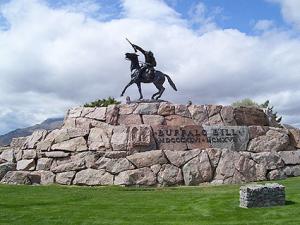 Buffalo Bill Cody Statue
Photo courtesy of Wikipedia Promoting Wyoming’s legacy became her passion. She next, proposed a gigantic statue of Buffalo Bill to be sculpted by Gertrude Vanderbilt Whitney, one of the country’s most famous artists. By then the people of Cody would support any suggestion their local author made, but the town could not afford Whitney. Lockhart proceeded to pester the sculptor until Whitney agreed to both sculpt the statue and raise the required funds. Whitney campaigned for funds amongst New York City’s wealthiest classes, establishing Buffalo Bill’s nationwide posthumous reputation.
After a few years, Lockhart tired of the day-to-day frustrations of the newspaper and guiding the Stampede. She believed local merchants never contributed all they could to an event that brought them so much business. She bristled at the incompetence of her co-owners at the newspaper, and her unpopular political positions made enemies and dampened profits.
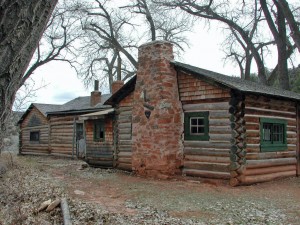 Lockhart cabin
Photo courtesy of NPS In 1925, Caroline decided instead of promoting the Old West lifestyle she loved so much, she would embrace it and she purchased her own homestead. She purchased a small 160 acre homestead, the L/♥, north of Lovell, Wyoming. She added land through purchase, homesteading, and leases until she controlled over 6,034 acres. From the owners she inherited a two-room cabin, a few run-down sheds, and 20 acres of cultivated ground. Lockhart added onto and landscaped the area around the cabin with irises, hollyhocks, cottonwood trees, and stone pathways. She constructed fences, corrals, and irrigation systems as well as adding 15 new structures.
Life on the L/♥ ranch was self-sufficient. Potatoes, apples, onions, carrots, dried beans and peas, along with beef, pork, and wild game were stored in the powerhouse/storage building. Milk, butter, and eggs went to the spring house for chilling. In 1935, three loads of Lockhart steers topped the market in Omaha, granting Lockhart her dream of becoming a Cattle Queen.
In 1952, Caroline decided she and her then-boyfriend were too old to continue running the ranch. Her eyesight was failing and ranch life had become too hard. She moved back to Cody, and lived the rest of her life in obscurity. Her only foray into society was inviting neighborhood children over to watch “Hopalong Cassidy,” on the only television in town. A show based on novels that in 1910 were considered inferior to her works.
Caroline Lockhart died on July 25, 1962. There was no funeral as she had requested her ashes be scattered over “the most convenient peak.”
A woman who not only loved Wyoming and the West, but did all in her power to see its legacy preserved! I’m a bit ashamed to admit that as a writer and Wyomingite the first I heard of this amazing woman was when I was diggin’ around for blog material.
But Cookie and me made fast tracks to meet up with Ms. Lockhart on the trail, some cause of her enduring story and some cause after all our time on the dark side of the trail Cookie needed a couple fingers of whiskey and with Prohibition and all Caroline was the only one servin’ the stuff!
We hope y’all enjoyed readin’ about this lady as much as we enjoyed diggin’ through newspapers and articles to meet her. My mind’s already turnin’ and twistin’ about a heroine based on the woman.
See y’all on the bright side of the trail!
SOURCES:
Cheyenne State Leader, no 136. Cheyenne, Wyoming. March 11, 1911, page 5.
Wyoming State Tribune, no. 93. Cheyenne, Wyoming. April 14, 1921, page 1.
Park County Enterprise, no. 32. Cody, Wyoming. March 17, 1920, page 1.
Wyoming State Tribune, no. 169. Cheyenne, Wyoming. June 30, 1921 [Morning edition], page 6.
Park County Enterprise, no. 36. Cody, Wyoming. April 13, 1921, page 1.
http://www.jstor.org/discover/10.2307/4518949?uid=3739256&uid=2&uid=4&sid=21101129651861
http://www.wyohistory.org/essays/old-west%E2%80%99s-female-champion-caroline-lockhart-and-wyoming%E2%80%99s-cowboy-heritage
http://www.nps.gov/bica/historyculture/caroline-lockhart-ranch.htm
Please won’t you all come over to the campfire and join Mr. Cookie and me in a refreshing beverage, or perhaps finger sandwich? *swoops into a deep curtsey and sweeps arm in grand gesture pointing to the campfire*
Yeah, I know Cookie, that ain’t gonna work! But I tried…So YEEEE-HAW, Folks!! Come on over and grab yerself some Arbuckle’s and a plate of grub!! Cookie and me, we tried real hard…for about thirty seconds…to put on some airs ‘cause today ‘round the campfire Cindy Nord, good FB friend and debut novelist, brought with her Colonel Reece Cutteridge, yes sir and ma’am a bonafide Yankee colonel!! A man in uniform…commence with the wolf calls gals ‘cause this man is H-O-T and not just ‘cause he’s forced to wear that darned wool uniform in the heat of August in Virginia. No, Siree, Reece would cause the vapors in nothin’ but what the good Lord…well let’s not even go down that trail or Cookie will have to use the smellin’ salts to revive us all!
**runs hand over Reece’s wool jacket covering a nice broad chest** “Sorry, I seem to have drooled a bit on yer fine uniform” **keeps runnin’ hand over the jacket long after the stain is gone. A whirlwind of satin plops down between me and the Colonel**
**Cindy laughs behind the ever present sandalwood fan**
**I glare at Cindy and the pile of satin now between me and Reece** Now normally only the hero and author swing by to share a cup and jaw, but today I’m pickin’ Cookie’s jaw off the ground cause Emaline McDaniels a spitfire of a Southern belle has graced our presence…mostly cause I couldn’t keep her away…an army couldn’t keep her away…
Folks we’ve got so much goin’ on ‘round the campfire today y’all better keep sharp, or you’ll miss somethin’!
Cindy, when she’s not causin’ dust storms flutterin’ her sandalwood fans and makin’ eyes at my cook, is an expert on Victorian fashion and she’s kindly supplied a bit of information on pantalettes!! Yep, folks today we’re mentionin’ the unmentionable!! Cookie, get yer doggone eyes off the split-crotch pantalettes!!
AND Cindy provided an excerpt from NO GREATER GLORY! If y’all can read the excerpt and not run off and snatch up a copy…well all I can say is good luck with that! When this lady comes to a shindig, she comes prepared!!
AND if’n I can tear Cookie away from those split-crotch thingmebobs, I’ll be puttin’ the names of those who take the time to leave a comment in his hat and we’ll giveaway an ebook (kindle or nook) copy of NO GREATER GLORY to one lucky commenter…
Let’s this soiree started folks, or we’re gonna run out of daylight! So let me proudly introduce y’all to Colonel Reece Cutteridge and the widow Mrs. Emaline McDaniels…
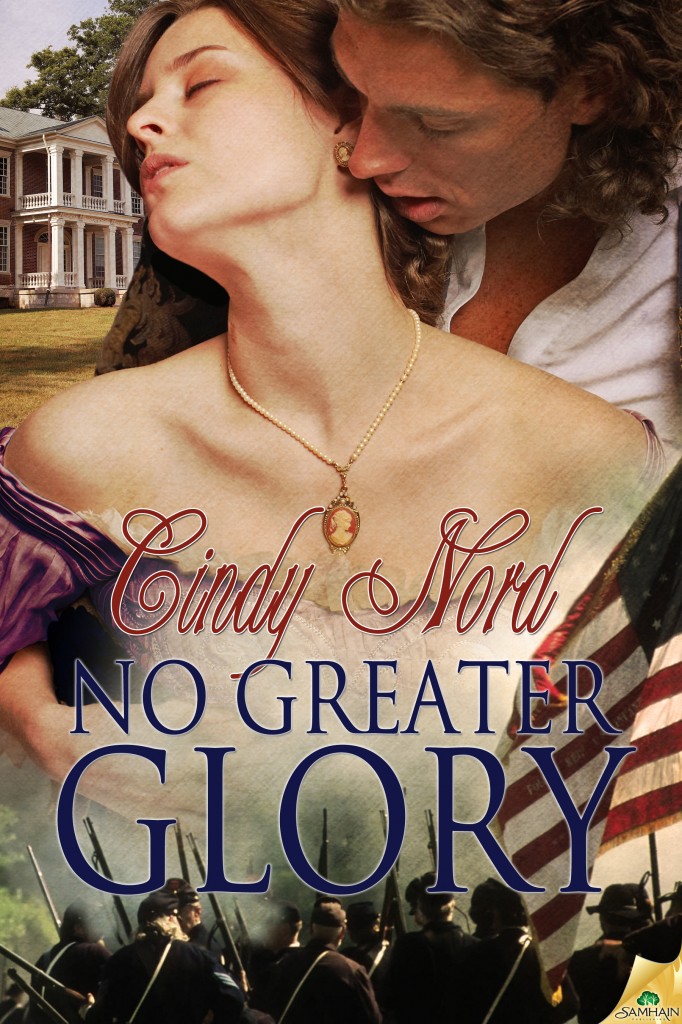 Amid the carnage of war, he commandeers far more than just her home. Amid the carnage of war, he commandeers far more than just her home.
Widowed plantation owner Emaline McDaniels has struggled to hold on to her late husband’s dreams. Despite the responsibilities resting on her shoulders, she’ll not let anyone wrest away what’s left of her way of life—particularly a Federal officer who wants to set up his regiment’s winter encampment on her land. With a defiance born of desperation, she defends her home as though it were the child she never had…and no mother gives up her child without a fight.
Despite the brazen wisp of a woman pointing a gun at his head, Colonel Reece Cutteridge has his orders. Requisition Shapinsay—and its valuable livestock—for his regiment’s use, and pay her with Union vouchers. He never expected her fierce determination, then her concern for his wounded, to upend his heart—and possibly his career.
As the Army of the Potomac goes dormant for the winter, battle lines are drawn inside the mansion. Yet just as their clash of wills shifts to forbidden passion, the tides of war sweep Reece away. And now their most desperate battle is to survive the bloody conflict in Virginia with their lives—and their love—intact.
KIRSTEN’S THOUGHTS: It has been a long time since I’ve read a love story so powerful and endearing as Cindy Nord’s, NO GREATER GLORY! I never believed there would be another story set during the American Civil War that reached my heart and hit me at such a gut level (forgive my vulgarity Emaline) as John Jakes’ NORTH AND SOUTH (the book that started a pre-teen down a path eventually focusing on Civil War history in college and graduate school), but NO GREATER GLORY meets and in some ways far exceeds my visceral reaction to NORTH AND SOUTH.
Cindy breathes life into not only her fictional characters, but into the historical figures and into the very history itself. Her battle scenes breath and roar like a dragon unleashed on the page, and the scenes between Reece and Emaline cut and bleed like an open wound as they try to deny their love and then soothe like a balm as they accept that while on opposite sides of a war, they will never be enemies. And though I’ve visited many Civil War battlefields and plantations, and live just down the road from most, it was Cindy’s writing that placed me smack in the middle of the sights, sounds, smells, and emotions of a nation torn apart by a war that severed and united a country just as it severed then united Emaline and Reece. From muddy battlefields, and field hospitals, to the lemon oil used to shine the wood at Shapinsay Plantation house, you are there with the characters through rich, historically accurate details.
Reece enters the scene a natural leader among men, and there is no doubt he is in command at all times, except where his heart is concerned when it comes to Emaline. His rugged exterior, while showing tenderness the only way a soldier during wartime can, by seeing to her safety, melts my heart even now. The heartbreak that drove him to war keeps Reece enslaved to the past.
Emaline is a brave, determined lady, but dragged down with the chains of responsibility and unwavering in her desire to protect the only child she believes she will ever have, her plantation. Emaline has known respect and admiration, but she has never really known love and acceptance…Until Reece.
I give NO GREATER GLORY my highest recommendation. You do not want to miss these two wonderful, sad, proud people find the true freedom no President can proclaim (even one as great as Lincoln) but only love can bring! OH, and you’ll LOVE Jackson and Brennen, too, I’m just sayin’!
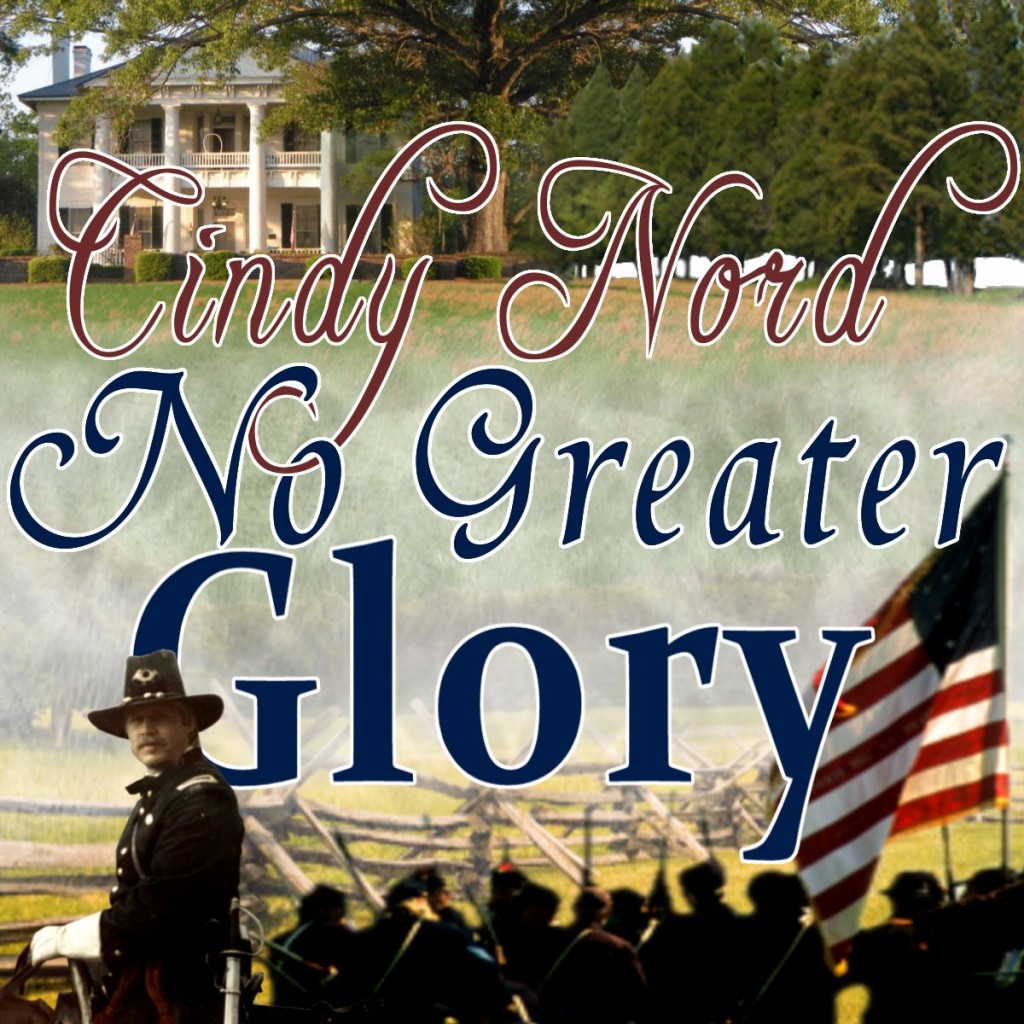
NOW here’s a peek at what I’m talkin’ about! (The picture is the cover to the Audio version of NO GREATER GLORY!! And that’s Cindy’s real life hero Tom leading the charge across the cover!! )
NO GREATER GLORY
October 1862
Seven miles west of Falmouth, Virginia
A bitter wind slammed through the tattered countryside, sucking warmth from the morning. Emaline McDaniels rocked back in the saddle when she heard the shout. She glanced over her shoulder and her eyes widened. Across the fields of ragged tobacco, her farrier rode toward her at breakneck speed. Lines of alarm carved their way across the old man’s ebony face.
Emaline spurred her horse around to meet him. “What’s wrong?”
Tacker pointed a gnarled finger eastward. “Yankees, Miz Emaline! Coming up da road from Falmouth!”
“Yankees?” Her heart lurched against her ribs. She’d heard of their thievery, the fires and destruction left in their wake. Teeth-gritting determination to save her home flashed through her. She leaned sideways, gripping his work-worn sleeve. “Are you sure they’re not the home guard?”
“No, ma’am. I seen ’em, dey’s blue riders, for sure. Hundreds of ’em.”
Two workers moved closer to listen to the exchange, and the farrier acknowledged them with a quick nod.
“Everyone back to the cabins,” Emaline snapped, sinking into the saddle. “And use the wagon road along the river. It’ll be safer.”
“Ain’t you comin’ with us?”
“No. Now move along quickly, all of you. And keep out of sight.” She flicked the reins and her horse headed straight across the fields toward the red-brick mansion that hugged the far edge of the horizon.
The spongy ground beneath the animal’s hooves churned into clods of flying mud. Aside from a few skirmishes nearby, the war had politely stayed east along the Old Plank Road around Fredericksburg.
Her mare crested the small hillock near the main house, and Emaline jerked back on the leather reins. Off to her far right, a column of cavalrymen numbering into the hundreds approached. The dust cloud stirred up by their horses draped in a heavy haze across the late-morning air. In numbed fascination, she stared at the pulsing line of blue-coated soldiers, a slithering serpent of destruction a quarter of a mile long.
Waves of nausea welled up from her belly.
“Oh my God…” she whispered. She dug her boot heels into the mare’s sides and the nimble sorrel sprang into another strong gallop. Praying she’d go unnoticed, Emaline leaned low, her thoughts racing faster than the horse. What do they want? Why are they here?
Her fingers curled into the coarse mane as seconds flew past. At last, she reached the back entrance of the mansion. Quickly dismounting, she smacked the beast’s sweaty flank to send it toward the stable then spun to meet the grim expression fixed upon the face of the old woman who waited for her at the bottom of the steps. “I need Benjamin’s rifle!”
“Everythin’s right dere, Miz Emaline. Right where you’d want it.” She shifted sideways and pointed to the .54 caliber Hawkins, leather cartridge box and powder flask lying across the riser like sentinels ready for battle. “Tacker told me ’bout the Yankees afore he rode out to find you.”
“Bless you, Euley.” Emaline swept up the expensive, custom-made hunting rifle her late husband treasured. The flask followed and she tumbled black crystals down the rifle’s long muzzle. A moment later, the metal rod clanked down inside the barrel to force a lead ball home.
She’d heard so many stories of the bluecoats’ cruelty. What if they came to kill us? The ramrod fell to the ground. With a display of courage she did not feel, Emaline heaved the weapon into her arms, swept past the old servant, and took the wooden steps two at a time.
There was no time left for what ifs.
“You stay out of sight now, Euley. I mean it.” The door banged shut behind Emaline as she disappeared into the house.
Each determined footfall through the mansion brought her closer and closer to the possibility of yet another change in her life. She eased open the front door and peered out across Shapinsay’s sweeping lawns. Dust clogged the air and sent another shiver skittering up her spine. She moved out onto the wide veranda, and with each step taken, her heart hammered in her chest. Five strides later, Emaline stopped at the main steps and centered herself between two massive Corinthian columns.
She squared her shoulders. She lifted her chin. She’d fought against heartbreak every day for three years since her husband’s death. She’d fought the constant fear of losing her beloved brother in battle. She fought against the effects of this foolhardy war that sent all but two of her field hands fleeing. If she could endure all that plus operate this plantation all alone to keep Benjamin’s dreams alive, then surely, this too, she could fight.
And the loaded weapon? Well, it was for her fortitude only.
She knew she couldn’t shoot them all.
“Please, don’t turn in,” she mumbled, but the supplication withered on her lips when the front of the long column halted near the fieldstone gateposts at the far end of the lane. Three cavalrymen turned toward her then approached in a steadfast, orderly fashion.
Her gaze skimmed over the first soldier holding a wooden staff, a swallow-tailed scrap of flag near its top whipping in the breeze. The diminutive silk bore an embroidered gold star surrounded by a laurel wreath, the words, US Cavalry-6th Ohio, stitched beneath. Emaline disregarded the second cavalryman and centered her attention directly upon the officer.
The man sat his horse as if he’d been born in the saddle, his weight distributed evenly across the leather. A dark slouch hat covered sable hair that fell well beyond the collar of his coat. Epaulets graced both broad shoulders, emphasizing his commanding look. A lifetime spent in the sun and saddle added a rugged cast to his sharp, even features.
An overwhelming ache throbbed behind her eyes. What if she had to shoot him?
Or worse—what if she couldn’t?
The officer reined his horse to a stop beside the front steps. His eyes, long-lashed and as brown as a bay stallion’s, caught and held hers. Though he appeared relaxed, Emaline sensed a latent fury roiling just beneath the surface of his calm.
Her hands weakened on the rifle and she leaned forward, a hair’s breadth, unwillingly sucked into his masculinity as night sucked into day. Inhaling deeply, she hoisted the Hawkins to her shoulder, aiming it at his chest. Obviously, in command, he would receive her lone bullet should he not heed her words. “Get off my land!”
Cindy’s bio: A member of numerous writing groups, Cindy’s work has finaled or won countless times, including the prestigious Romance Writers of America National Golden Heart Contest. A luscious blend of history and romance, her stories meld both genres around fast-paced action and emotionally driven characters. Indeed….true love awaits you in the writings of Cindy Nord
WHOO-EEE!! But don’t go yet, although I know y’ave got a bur to get yerself a copy! But you DO NOT want to miss the following discussion on…hm umm…underdrawers…!!!
Victorian Unmentionables…Oh My!
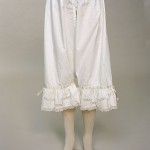 1865 pantalettes Today we call them panties, underwear, or ladies briefs. Even a few brave souls, might wear and call them thong. But in the 1860’s, modesty was foremost. And the proper ladies of the era might call these items her…‘unmentionables” if in a crowd, but behind fluttering fans she’d address them by the name they actually were: split or crotchless pantalettes (two separate tubes of material joined to a band only at the waist, the crotch left open for hygienic reasons). When we say we’re wearing a ‘pair of panties’– THIS is where that saying derived.
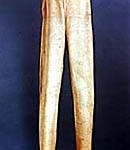 Men’s long drawers
courtesy employees.oneonta.edu Originating from France in the early 19th century, the feminine pantalettes were designed after men’s leggings or long drawers. Up to this time, ladies did not wear anything other than a long chemise or shift. The acceptance by females of these pantelettes soon spread to Britain and quickly swept across the pond to America.
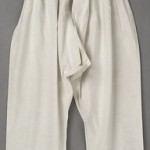 pantelettes 1866
courtesy Metropolitan Museum The pantalettes of an 1860’s woman were loose trouser-like pieces made mostly from white linen or silk and decorated with tucks, lace, and cutwork or broderie anglaise. Also called drawers (so stated because the undergarment was ‘drawn on’), they were worn mid calf-length with an open leg and the hems were decorated with scallops or elegant embroidery. Secured at the waist with a tie or a back button closure, these garments were always part of the wardrobe and worn for decency’s sake as ladies limbs at the time were never exposed. And the split-crotch made going to the “necessary” a whole lot easier.
 Godey’s Lady’s Book pattern Beginning as simple fashions of the early 1800’s, by the Mid-Victorian era, pantalettes had become an exquisite work of art. Women found fashion inspiration and patterns from Godey’s Lady’s Book and Petterson’s — and both popular periodicals featured new looks each month. Pantalettes patterns were no exception, and issues during this time-period included patterns with measurements, and an illustration of the completed garment.
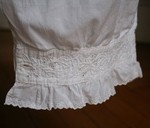 Details at bottom of piece
courtesy abitiantichi.it
By the end of the 1860’s decade, however, pantalettes legs were no longer separate tubes attach to a simple band. The split-crotch opening disappeared into one complete garment seamed into one piece, most likely joined to prevent chafing caused by damp skin rubbing together. And soon thereafter the length of the garment rose from mid-shin into gathers just below the knee.
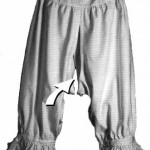 1869 split-crotch pantalettes
courtesy of mum.org There were numerous layers of undergarments worn by a properly dressed 1860’s Victorian lady. But by far the most important piece of clothing other than the corset (which so defined a woman’s silhouette of that era) was the pantalettes.
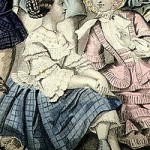 Girls with pantalettes showing
Godey’s Ladies Book, 1855
Cookie!! Dagnabbit, yer embarrasin’ me in front of the Colonel, starin’ at those bloomers!! And don’t be askin’ Emaline for a close-up look! Though if Reece was so inclined…
Anywho folks, this shindig is just startin’ and the fun is fixin’ to last all day!! So, come on over and jaw a bit, or swoon at the Colonel’s feet! Feel free to ask Cindy about pantelettes! (I defer all bloomer questions to her)! Do you like Civil War novels? What color does your hero usually don (I have to admit the couple I’ve written about wear the Gray)? What’s your favorite Civil War novel, if ya have one…other than NO GREATER GLORY, of course!! Heck talk about anythin’! It’s a free country…now!
We’re not done with those sidewinder cattle barons, folks! Yep their still a burr in everyone’s backside kinda like Cookie! Aw, don’t get yer longjohns in a twist!
Now back to the real problem, and I’m not talkin’ about Cookie’s mulligan stew, today we’re talkin’ about the last big sheep raid in Wyoming, The Spring Creek Raid…
Cattlemen started driving large herds into the Big Horn Basin in the 1870s. Since they arrived first the cattlemen claimed prior rights to the grass on government lands for their herds to graze. However, the law stated otherwise giving sheepmen and cattlemen equal rights to the resources on public lands. Laws in the early 1900s made it a first come first serve situation and neither could claim rights over the grazing lands.
As discussed in the previous blogs on the Johnson County War and Tom Horn, the cattlemen of the late 1800s suffered from cattle glut on the grazing lands and targeted small ranchers driving them from their land by threat or by murder. Once things began to cool between the large and small cattle ranchers, all cattlemen turned their eyes toward a common enemy…the sheepmen.
The rising number of sheep on the range increased the pressure on the cattlemen. Sheep outnumbered cattle in Wyoming by the early 1890s. By 1894 there were 1.7 million sheep in Wyoming and 675,000 cattle. By 1909, there were more than six million sheep and only 675,000 cattle.
For those who don’t know, sheep consume the grass for miles. They eat down to the bare ground and when they leave a territory there isn’t any feed left for any other livestock. This makes it impossible for cattle to range with sheep. And at a time when the Wyoming range due to droughts, devastating winters and already over stocked ranges for cattlemen to watch thousands of sheep move onto open range divest it of all feed and move on was unthinkable.
The response, typical of the cattle barons, was to use violence to enforce their claims over the range. The cattlemen declared pieces of range off limits to sheep (the rule being “fence sheep in, fence cattle out). These men and their hired guns wreaked havoc upon the sheepherders and their property. For years a sheepherder would go missing, or be found shot on the range. A few men, like Tom Horn, would be tried and possibly convicted, but for the most part these murders and intimidations went unpunished and the sheepmen were left to their own defenses.
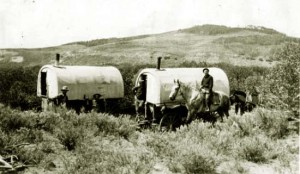
The cattlemen carried a chip on their shoulders and from their viewpoint were justified in the deprecations they inflicted on sheepmen and their wooly bands. One case, a sheepherder was taking a band (2,000 to 3,000 sheep) over the Big Horn range. He camped near the summit; a number of masked riders rode into camp about noon. The spokesman told the herder the altitude was entirely too high for his heart, and if he insisted on remaining up there it was sure quit on him, but if he would seek a much lower altitude, he might live to be an old man. The herder took the hint and beat a hasty retreat to the valley. After he left, abandoning his animals, the masked riders put the harness, a mother dog and her puppies in the wagon closed the door, tied the team of workhorses to the wagon wheels, poured kerosene over the wagon and set it on fire. They proceeded to shoot at least 50 sheep. Some had their eyes shot out, some with broken backs, legs shot off, some of their entrails hanging out. The men cut green Quaking Aspens clubs beat out the woolies brains.
The violence escalated and the sheepherders, determined to protect their herds and livelihood, formed the Wyoming Wool Growers Association in 1905. This Association would play an important role in prosecuting the men who carried out the Spring Creek Raid.
The last armed conflict between cattlemen and sheepmen occurred in the Nowood Valley at Spring Creek, seven miles southeast of Ten Sleep, Wyoming. The raid started in the spring of 1909, when two sheepmen, Joe Allemand and Joe Emge, along with three sheepherders drove 2,500 sheep from Worland, Wyoming east to Ten Sleep, about 25 miles. Allemand was a quiet man and admired by both cattleman and sheepmen of the area. An emigrant from France, Joe was an unassuming man married with three children. He had good credit and was a member of the Masonic Lodge. He kept his sheep on his own domain except in summer when he drove them to the mountain range.
Due to financial difficulties, Allemand sold a partnership to Joe Emge, a man not well-liked. A former cattleman, Emge, boasted he’d graze his sheep any place he liked and planned to run the cattlemen off the range.
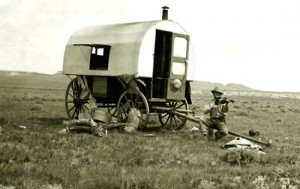
On April 2, 1909, Allemand telephoned his wife from Ten Sleep telling her he would be home that evening. Listeners over the party line informed Emge’s enemies Allemand would not be in camp that night. Visitors to the camp from a nearby ranch disrupted Allemand’s plan when they stayed for supper. By the time they left Allemand determined it was too late to ride home. Allemand and his young nephew, Jules Lazier (a French subject) and Emge slept in the upper wagon. A young herder, sixteen-year-old Bounce Helmer and another Frenchman, Pete Cafferal, were in the lower wagon.
As darkness fell, seven raiders rode into camp. Two headed straight for the wagon, while five went after the sheep. The raiders fired shots and Helmer, fearing for his dogs, ran from the wagon. He was captured by the raiders along with Cafferal and both were tied up. Helmer recognized some of the men in the light of a lantern he’d lit.
No one emerged from the upper wagon and the raiders started firing into it. One man started a fire by throwing kerosene from Helmer’s lantern on the sagebrush under the sheepwagon. Allemand came out of the wagon and was shot down. The fire consumed Emge and Lazier before either could escape the wagon. When the raiders realized they’d killed Allemand, they fled. Helmer and Cafferal were able to free themselves and run to a neighbor’s for help.
When the Big Horn County sheriff, Felix Alston, reached the scene of the raid Joe Allemands body was lying near the smoldering embers of the sheep wagon a sheep dog’s puppy curled upon his chest. The charred bodies of Emge and Lazier were found nearby. The raiders left a trail of devastation. They killed dogs, sheep, and destroyed thousands of dollars of personal property. It was the deadliest sheep raid in Wyoming history.
Big Horn County used money forwarded by the Wool Growers Association to hire attorneys, cover the costs of trial and pay for essential actions such as concealing witnesses for their protection and for the protection of the case. Sheepmen contributed to the obtain the services of range detective, Joe LeFors, well known for his role in the conviction of Tom Horn, and therefore a man respected by the sheepmen of Wyoming.
Unlike during the Johnson County War and previous actions against small cattlemen and sheepmen, officials were not going to turn a blind eye to this raid. Big Horn County officials began an aggressive investigation into the Spring Creek Raid and quickly established solid evidence against seven cattlemen, all charged with murder and arson. These men were: George Saban, Milton Alexander, Ed Eaton, Herb Brink, Tommy Dixon, Charles Ferris, and Albert “Bill” Keyes.
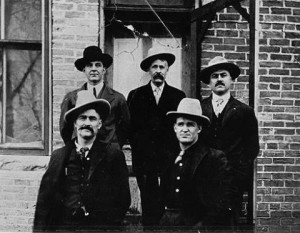 Defendants in Spring Creek Raid Charles Ferris and Bill Keyes turned state’s evidence. The remaining five, comprised of two ranchers, two cowboys and a former cowboy waited in the Big Horn County jail confident that the case against them wouldn’t even go to trial. These men knew the dismal Wyoming history for prosecuting sheep raiders, and the disastrous attempts to prosecute men engage in extralegal activities, such as the invaders during the Johnson County War, where the case never went to trial and the invaders received support from the governor himself.
And one of the men, George Saban, had personal experience with the often faulty Wyoming justice. As a participant in a July 1903 raid on the county jail which ended with two prisoners and deputy sheriff killed. The case against Saban and his colleagues collapsed under an atmosphere of intimidation.
A few cattlemen collected a large pool of money to fund the legal expenses of the defendants, and private lawyers were obtained to represent the raiders. Prominent politicians such as “Bear” George McClellan supported the raiders along with area newspapers. But things had changed in the Big Horn Basin by 1909, and all attempts to frighten witnesses, intimidate judicial authorities and frustrate jury selection failed.
One of the main reasons for this was a large new irrigation project that brought in farmers to the Big Horn Basin. As farmers, they had no particular sympathies for either cattleman or sheepman. Also, the governor of Wyoming was Bryant B. Brooks, a prominent sheepman, which probably added to his willingness to exercise state authority. He ordered the Wyoming militia to guard the streets of Basin City and keep citizens safe.
Contrary to the beliefs of the sheep raiders in November 1909 the trials did proceed. Herb Brink was the first brought to trial, and to the surprise of many there was little trouble in seating a jury. Farmers, with no stake either way, filled many of the seats, and the state militia kept order in the streets. The case was tried in the courtroom and not in the court of public opinion as many previous cases.
The state’s evidence provided by Albert “Bill” Keyes and Charles Ferris proved to be the most damaging as they spilled the whole story of the plan and the events the night of the raid including how Allemand staggered from the wagon and walked slowly away from it with his hands raised. Brink shot him dead, saying, “It’s a hell of a time of night to come out with your hands up.”
The State was well represented by the attorneys specially hired to assist the prosecution. Those lawyers included two from Sheridan, E. E. Enterline and William Metz, father of elected Big Horn County Attorney Percy Metz. The prosecution also included W.L. “Billy” Simpson, father of future Wyoming Governor Milward Simpson and grandfather of future Wyoming Senator Al Simpson. Billy Simpson had represented sheep raisers in various cases in the Big Horn Basin before 1909 and was therefore tainted in the minds of cattlemen. This was probably the reason he was not hired for the defense.
Eyewitnesses, including sheepherder Bounce Helmer, and three men who watched the raid from an adjacent house all testified. The raiders did not help their case by making the critical mistake of talking to their acquaintances. Billy Goodrich, whose testimony was secured by LeFors and who was the employer of two of the raiders, told the jury about a series of admissions made by Brink.
The jury convicted Brink of first-degree murder and sentenced him to hang. After this development, his fellow raiders stampeded to make separate deals with the prosecution. Brink’s death sentence was commuted, but five of the seven Spring Creek raiders were sentenced to serve prison terms. The two who testified for the prosecution were provided immunity.
The raiders’ fate was as follows: Eaton died in state custody. Saban escaped in 1913 and was never recaptured. Dixon was paroled in 1912. Brink and Alexander were paroled in 1914.
The convictions from the Spring Creek Raid put a stop to the havoc committed against Wyoming sheepmen. After 1909, there were only two minor raids in the entire state, and no one was injured in either. One of the prosecutors, Will Metz, summarized the meaning of the verdicts by saying, “It is significant of the beginning of a new era, of a period where lawlessness in any form will be no more tolerated [in Wyoming] than in the more densely settled communities of the east.”
And that folks is an example to all not to let the wool be pulled over yer eyes!
Don’t know about y’all but Cookie and me are amazed at how the same personalities, both good and bad, tend to keep showin’ up in all of these raids. Guess it’s true what they say about a bad penny! And doggonit if Cookie isn’t proof of that…Aw come on y’all saw that one comin’!
Now I’m off with ol’ Cookie, if’n he’ll let me on the same trail, into the sunset where we’ll be diggin’ up more Wyomin’ history! The good, the bad, and the ugly of it all!
See ya on the trail!!
SOURCES:
http://www.wyohistory.org/essays/spring-creek-raid
http://www.travel-to-wyoming.com/tensleep/spring_creek_raid.htm
https://sites.google.com/a/wyo.gov/the-spring-creek-raid-by-felix-alston/
Kathleen Rice Adams, talented writer and my Texas rival in gatherin’ all those wonderful maverick hunks, tagged me in the LOOK Challenge. “Look” is one of those words for which writers are always on the lookout. Like other words related to the senses, “look” can distance readers from the point-of-view character’s experience, so we try to use it with caution. The Look Challenge is a game writers play to remind us to keep an eye out for the overused word and replace it with something more evocative when appropriate. (Plus, the game lets us show off snippets of our works in progress.)
The rules of the Look Challenge require those who’ve been tagged to find the first occurrence of “look” in their work in progress, and then post that sentence and the surrounding paragraph(s). Then they have to tag an unspecified number of friends. Here’s my contribution. This is from the first draft of my wip OPEN FIRES a Western Historical:
He tipped back his Stetson. “Well I won’t smell pretty, Miss Walker, but I’ll be just fine in my shirt and denims.”
Her mouth curved in what might have been the start of a smile for less than a second. She rose gathering the buckskins to her chest. He unfolded from the ground and looked around until he had to make a move. “I’ll just step outside while you change.”
Again a small hand rested on his stopping him quicker than a bullet. She stripped his coat from her shoulders. “You need this.” A tremor shook her body.
“No ma’am you…”
She gave her head a small shake and a flash of fire ignited behind the fear and shock in her eyes. No matter what ordeal the woman faced recently, Nathan recognized an iron will. That warm feeling in his belly started again. He yanked on the coat and stepped outside into the cold Montana night. How the hell did he get into this?
Copyright @ 2012 Kirsten Lynn (no re-printing or copying without permission from the author)
WHOOO-EEE, Cookie, did ya park this wagon on the sun?! Guess it just must be the super H-O-T cowboys Ms. Gem Sivad brought along to share the campfire! These are the heroes of her Eclipse Heat series and when Gem says HEAT she’s not just whistlin’ Dixie! These men know how to turn it up with just a look…and they are lookin’ mighty fine! But even as I settle on down in between all this blazin’ man flesh I’m a might careful not to touch, cause these men are roped, tied and branded by some of the bravest and iffin’ I can complain the most uncharitable bunch of women in Texas! Why all I’m askin’ for is just one or two or three…okay I’d take all these hunks!
As though it wasn’t already hotter than a lizard on a rock in the middle of the Texas desert, Gem is offerin’ up not one but TWO ebooks! One lucky commenter (the first name out of the Stetson) will win a copy of QUINCY’S WOMAN! While another lucky person (second name out of the Stetson) leavin’ a comment will win a copy of PERFECT STRANGERS! I tell ya folks y’all thought your summer was hot, wait ‘til ya meet the men of Eclipse! There’s not enough iced tea in the world!
And don’t miss Gem’s message after all my jawin’s done to find out what’s in store for Eclipse!!
So grab an iced coffee from Cookie, and a bucket of ice water to pour over yer head, and let me make all the proper introductions!
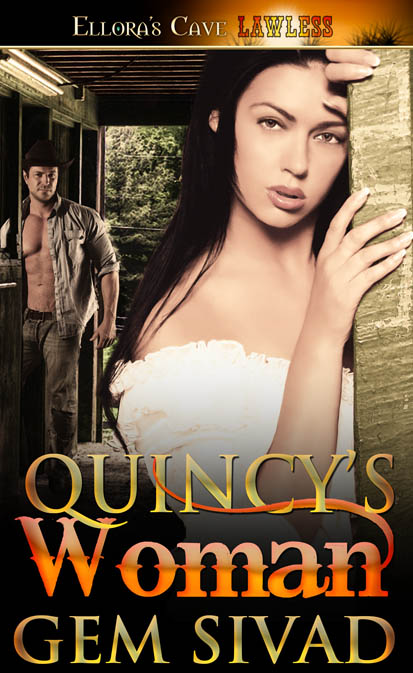 Fresh from the post-Civil War salons and drawing rooms of Boston, Lucy McKenna considers herself a sophisticated young woman. But when she meets Texas rancher Ambrose Quince, she turns into a flustered girl. He’s too old, war roughened and unrefined and she has no idea how to deal with the sensual hunger he arouses within her. Fresh from the post-Civil War salons and drawing rooms of Boston, Lucy McKenna considers herself a sophisticated young woman. But when she meets Texas rancher Ambrose Quince, she turns into a flustered girl. He’s too old, war roughened and unrefined and she has no idea how to deal with the sensual hunger he arouses within her.
Ambrose falls fast and hard for the innocent debutante visiting Eclipse, Texas. Persuading Lucy to accept his pursuit becomes a duel of wits and passion as he awakens her desire.
Lucy leaves Boston and childhood behind when she becomes Mrs. Ambrose Quince. Her lonely days on the Double-Q ranch are filled with work and frustration. But she spends each night in her husband’s arms learning carnal awareness one molten caress at a time.
KIRSTEN’S THOUGHTS: QUINCY’S WOMAN is the journal of Lucy McKenna Quince. I have to admit I’m a bit leery of first person narratives and when a book is supposed to be the journal of one of the characters. But Gem sold me! From page one it was like truly reading a journal I found in a dusty attic of a young woman struggling in an unfamiliar world and as a new bride to a rough Texas rancher who represents everything she detests and everything she desires.
When we’re introduced to Lucy McKenna she is spoiled and while intelligent doesn’t have much common sense. But I never found her an unlikable young lady, even during times when I’d like to shake some sense into her, she just seemed to be exactly what she was a young woman forced to move from everything and everyone she knows to a country that is worlds away from her comfort zone, so she tries to make everything and everyone around her conform to what she used to have and know.
Enter Ambrose Quince who is 100% man and 100% Texas rancher, but wants Lucy and is willing to give her anything to have her. At the same time he is unyielding and believes he knows best in any and all circumstances.
The two start a journey toward meeting in the middle in QUINCY’S WOMAN, but it will take another book and a lot of heartache before they reach a real understanding and appreciation for what they can be together.
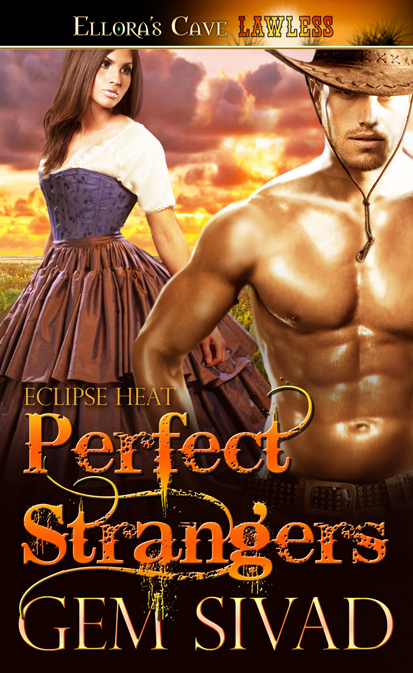
Lucy and Ambrose Quince share fiery passion in and out of bed; they love hard but fight often, both having opinions and tempers. But Lucy mysteriously disappears in 1874, leaving the Double-Q ranch and all she loves behind. Three years later, scarred in mind and body, Lucy is drawn back to Eclipse and the life she’s forgotten—including a snarling, lustful husband.
Although she claims she can’t remember him, Ambrose hasn’t forgotten a damned thing. Lucy left him and he owes her nothing. Trouble is—his heart remembers too, and Lucy’s the only woman who’ll ever own it.
KIRSTEN’S THOUGHTS: PERFECT STRANGERS is a go to book for me. I don’t know how many times I’ve turned to Ambrose and Lucy’s story when I feel like reading, but want to delve into a story I know will satisfy me every time. It’s certainly not a fluff piece, or really even a feel good book, but I love it. It’s real and gritty and I just fall in love with the characters and story every time delve into the world of Eclipse and the Double-Q Ranch. Really, it’s a good thing I have this book on kindle because the pages would be falling out of a paperback by now.
I read PERFECT STRANGERS before I read QUINCY’S WOMAN. When QUINCY’S WOMAN was released I read it and then read PERFECT STRANGERS again to follow Ambrose and Lucy’s story from the beginning. This was enlightening as to how the couple got to where they were at the beginning of PERFECT STRANGERS both as a couple with great passion for each other, but two extremely stubborn people not willing to give an inch.
At the beginning of PERFECT STRANGERS Lucy is pretty much the same woman we left at the end of QUINCY’S WOMAN. She is still spoiled with a tendency to fly off the handle. Boy does that change when she reenters the picture after suffering memory loss from a brutal attack. I don’t want to give anything away, but her initial reintroduction to Eclipse is one of my favorite scenes from any western. But what I enjoyed more than Lucy’s transformation to a stronger, more self-sufficient woman, was her new found strength of heart. My heart ached for Lucy as her children, Ambrose, and the citizens of Eclipse revealed her past nature and she had to restore relationships, but at the same time assert herself as who she was, not who she had been.
At the same time Lucy is learning and dealing with her past, Ambrose, too, must face his past and mistakes he made in their relationship and his part in its destruction. Ambrose is gruff, rough and bossy, and I just love him to death, because most of his gruffness comes from loving Lucy so much and not wanting her to have control over his heart yet being unable to control how much he loves her (and Ambrose hates not being in control). As he fumbles, seduces and strong-arms his way into her heart he’ll claim your heart, as well.
The tender moments between the couple were made the sweeter because of the iron resolve of each, so when it bent to meet the other halfway it meant more than a weak spirit, which bends whenever the wind blows. Ambrose and Lucy are a dynamic, unbeatable team when they set aside all the misconceptions and distrust to rebuild their lives, restore their family, and destroy those who tried to separate them.
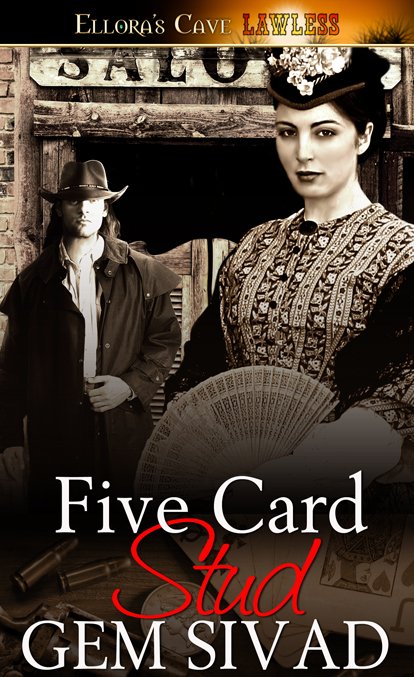 Although Sam McCallister’s watching a poker game the first time he sees Eden Pace, he loses all interest in the cards when the thought of playing stud with the lady gambler stirs lust to life. Eden’s the prettiest woman and the best card sharp Sam’s ever met. She’s only interested in poker but Sam has other games in mind. Although Sam McCallister’s watching a poker game the first time he sees Eden Pace, he loses all interest in the cards when the thought of playing stud with the lady gambler stirs lust to life. Eden’s the prettiest woman and the best card sharp Sam’s ever met. She’s only interested in poker but Sam has other games in mind.
Sam, being a bounty hunter, discovers Eden’s wanted for murder. He plans on keeping her safe–a prisoner in his bed. But Eden’s doing her own outlaw hunting. She’s on the trail of her husband’s killer and Sam’s in her way. To get free from the hard-headed, soft-hearted, gorgeous man, she uses every sensual trick she knows–and Sam soon discovers she knows plenty.
Eden’s planning a showdown with a monster only she can identify. Protecting her puts Sam at risk. He’s in a high-stakes poker game with hearts on the table and forever on the line. Winning’s the only option because one taste of Eden will never be enough.
KIRSTEN’S THOUGHTS: I read FIVE CARD STUD when it was first released and loved the story. Then a few days ago I decided to skim through these books again just to make sure I was remembering everything correctly. Well my skim through FIVE CARD STUD turned into reading the whole thing and finding out I didn’t just love this story and the characters, but I adored this story and wondered what medication I was on the first time through that I didn’t recognize how remarkable this story is. Sam and Eden are fabulous multidimensional characters!
Sam is the boy in school who pulls the girl’s pigtails until she either decks him, realizes she likes him, or both. He’s just plain irresistible and the more his character is revealed the more he just moves right into your heart. His playful nature brings splashes of light into a dark story of murder and revenge. But don’t get too comfortable with his smile, because he’s as deadly as they come, which just adds to his appeal. Who doesn’t love a man who can make you laugh even when you’re spitting mad at him and at the same time his very name strikes fear into your enemy? Add to that he has more swagger than any man should be allowed, but inside wants to find acceptance and love. Sam is definitely not afraid to use tenderness…or whatever else he’s been graced with to win Eden’s heart.
Eden is a woman in desperate need of a man to tug on her braids as well as her heart strings and bring her back to life. She’s a passionate woman who has forgotten that passion until Sam reminds her (and whoa baby does he remind her). Gem does a magnificent job of bringing the reader inside Eden’s head, heart and pain as she learns to let go of the past and hold fast to what the future can hold.
This is an ace-high story with characters who go straight to the heart as they pit iron will against iron will in the ultimate game of Texas Hold ‘Em. (Okay I’m done with the card references. Aren’t ya glad I didn’t say Sam and Eden will be the king and queen of your hearts?)
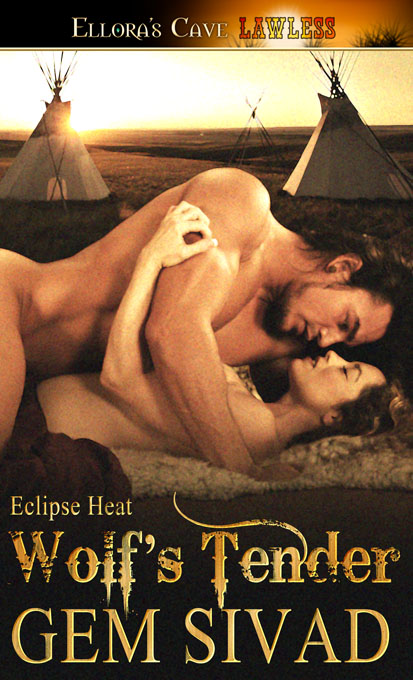 Naomi Parker needs to follow the trail of marauding Comancheros who have kidnapped her students. But the best tracker in the state is Charlie Wolf McCallister and he works for cash. Naomi Parker needs to follow the trail of marauding Comancheros who have kidnapped her students. But the best tracker in the state is Charlie Wolf McCallister and he works for cash.
Not one to let unfavorable circumstances stand in her way, Naomi bargains with him–a night of seduction for his services. Though their sexual encounter leaves her amazed and bemused, she has no illusions. Charlie Wolf agreed to help because he’s after a huge outlaw reward.
Charlie laughs a lot at the know-it-all school marm’s ideas. For all her smarts, sometimes she doesn’t have a lick of common sense. He has a whole different reason for joining Miss Parker’s hunt. The bounty Charlie’s after is Naomi’s heart.
KIRSTEN’S THOUGHTS: WOLF’S TENDER was actually the first book I read of Gem’s and I was hooked. It was published by a different publisher, and I cannot wait to read the new expanded version! Hey, I’ll take all the time I can get with Charlie Wolf McCallister! Watch for this one folks! You don’t want to miss Charlie and Naomi’s story! I mean seriously NOT to be missed. This story is packed full of action, the McCallister dry humor, heart and scenes so hot you’ll crank up the air conditioner in January!
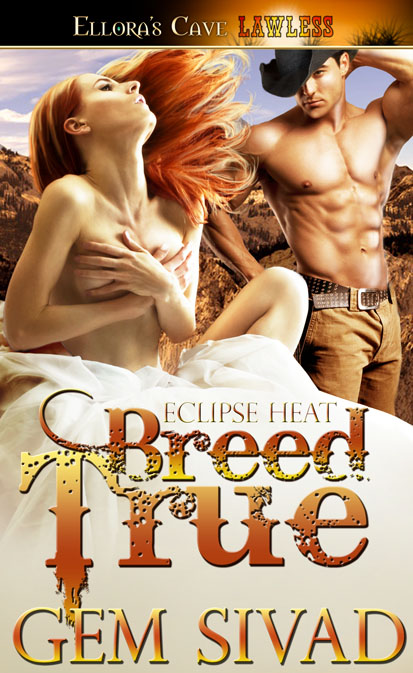
Necessity breeds strange bedfellows. Making a devil’s bargain, Julie Fulton agrees to marry Grady Hawks and produce the son he needs to inherit Hawks Nest ranch. At the end of a year, child or not, Julie will receive enough money to escape to San Francisco and leave behind the rough existence she lives.
Grady intends to breed back to the fair skin and Scottish features of his father and Julie meets every requirement. Her red hair and pale skin are an excellent way to dilute Grady’s half Kiowa blood and save his land from an Eastern business consortium.
The formula is right, but the outcome unexpected. Siring a son is the last thing on Grady’s mind when he discovers pleasure in Julie’s bed. And San Francisco no longer seems like paradise to Julie when she finds heaven in Grady’s arms.
KIRSTEN’S THOUGHTS: BREED TRUE is another of the Eclipse series that has been expanded and will be re-released. And it is another must read! This story doesn’t have quite the hero and heroine going up against a visible enemy storyline like the McCallister stories, or even PERFECT STRANGERS. BREED TRUE is about Julie and Grady finding and fighting their way through preconceived ideas and prejudices to discover where they belong. And do I have to mention the heat level, just look at that cover!!
That’s all I’m going to say about WOLF’S TENDER and BREED TRUE as I’m hoping *smiles at Gem* to feature those after their re-release.
Gem’s westerns are some of the best I’ve read. They don’t gently tug you into the town of Eclipse, they yank you right off the chair and slam you onto a Texas road leaving you sputtering thick Texas dust and baking in the sun. And just when you think things couldn’t get hotter she strikes the lucifer and turns up the fire with those chiseled, uncontrollable, unpolished, always sizzling, charming devil heroes and teams them up with iron willed, intelligent, resourceful women. What I love most about this series is while there’s plenty of action, in and out of the bedroom and bedroll, they’re also amazing stories. She doesn’t just take you from one sizzling moment to the next. Her stories give a complete picture of the men and women of Eclipse, Texas, from their struggles to keep their livelihood to their battles against enemies, and then the internal conflicts to be accepted and find the one to share their lives. The people of Eclipse are authentic from the main characters to the supporting cast. You’re introduced to vibrant, colorful, real characters and thrown right in the middle of their lives to laugh, cry, and cheer them on, or in the case of the villains you wish someone would pass over a Colt .45 so you could help ’em meet a painful end.
A bonus to her hero and heroines is each knows and respects the strengths and weaknesses of the other. The heroines, even if begrudgingly, accept the hero’s expertise and skill, and defer to them when necessary. The heroes respect and admire their heroines’ abilities and encourage them to use their talents.
If you’re looking for sonnet spoutin’ heroes who use flowery words and heroines who fawn all over them, or scream and get in the way during a showdown, DO NOT read these books. If you want Western heroes and heroines you could believe walked off the pages of a history book then load up the kindle, nook, or grab paperbacks (when available) of this series!
These aren’t people you’ll forget anytime soon, and if you’re anything like me, you’ll visit Eclipse over and over again.
GEM’S MESSAGE!

Hi everyone. *waving* Thank you, Kirsten, for inviting me to your blog, today and giving me the opportunity to talk about my historical western series published by Ellora’s Cave. To date, I’ve written six books in the Eclipse Heat series and I’m currently working on a contracted seventh—Whispering Grace.
Available now—Quincy’s Woman; Perfect Strangers; Five Card Stud
Coming in 2012 (or early 2013)—Wolf’s Tender; Breed True
Coming in 2013— Trouble in Disguise; Whispering Grace
Each book is a stand-alone romance linked to the others by the setting—1880’s Eclipse, Texas. I hadn’t planned to write a series, but during the research process, I became addicted to that particular time period and landscape. If you’re interested in reading the series, I recommend that readers begin with Quincy’s Woman and Perfect Strangers, the two titles I’m giving away today. Leave a comment and Kirsten will let me know who wins the drawing. Good luck. Hope you enjoy.
Thanks for stopping by,
Gem
Sweet summer rain, folks! I’m soaking in tin tub of ice cubes before I combust! Cookie keep ‘em comin’!! We’ve got four more Eclipse stories to wait for, I’m about to have a heart seizure! I’ll just hang onto Ambrose…or maybe Sam…or Charlie…or Grady…Well ya see the dilemma! While Cookie tries to keep me away from all this Texas heat; come ‘round the campfire and jaw a bit.
In most of Gem’s Eclipse Heat books there is a paranormal element revolving around an Apache warrior priestess, Lozen (who is an actual historical figure and sister to Apache leader Victorio) and her encounters with the characters in the story. I really enjoy this element of the stories. Do you enjoy when authors use paranormal elements in their stories (even if based on history) or not?
|
|
 Thank y’all for comin’ on over to the campfire! You’ve probably been wonderin’ about Cookie and me…then again maybe not! We’ve been on a break, but don’t fret we’ll be back on the trail soon. I’ve been knee deep in writin’ and Cookie has been knee deep in…well y’all know! So please don’t give up on us and keep checkin’ back! In the meantime enjoy the Saturday story RACE TO MARRY!
Thank y’all for comin’ on over to the campfire! You’ve probably been wonderin’ about Cookie and me…then again maybe not! We’ve been on a break, but don’t fret we’ll be back on the trail soon. I’ve been knee deep in writin’ and Cookie has been knee deep in…well y’all know! So please don’t give up on us and keep checkin’ back! In the meantime enjoy the Saturday story RACE TO MARRY!

























